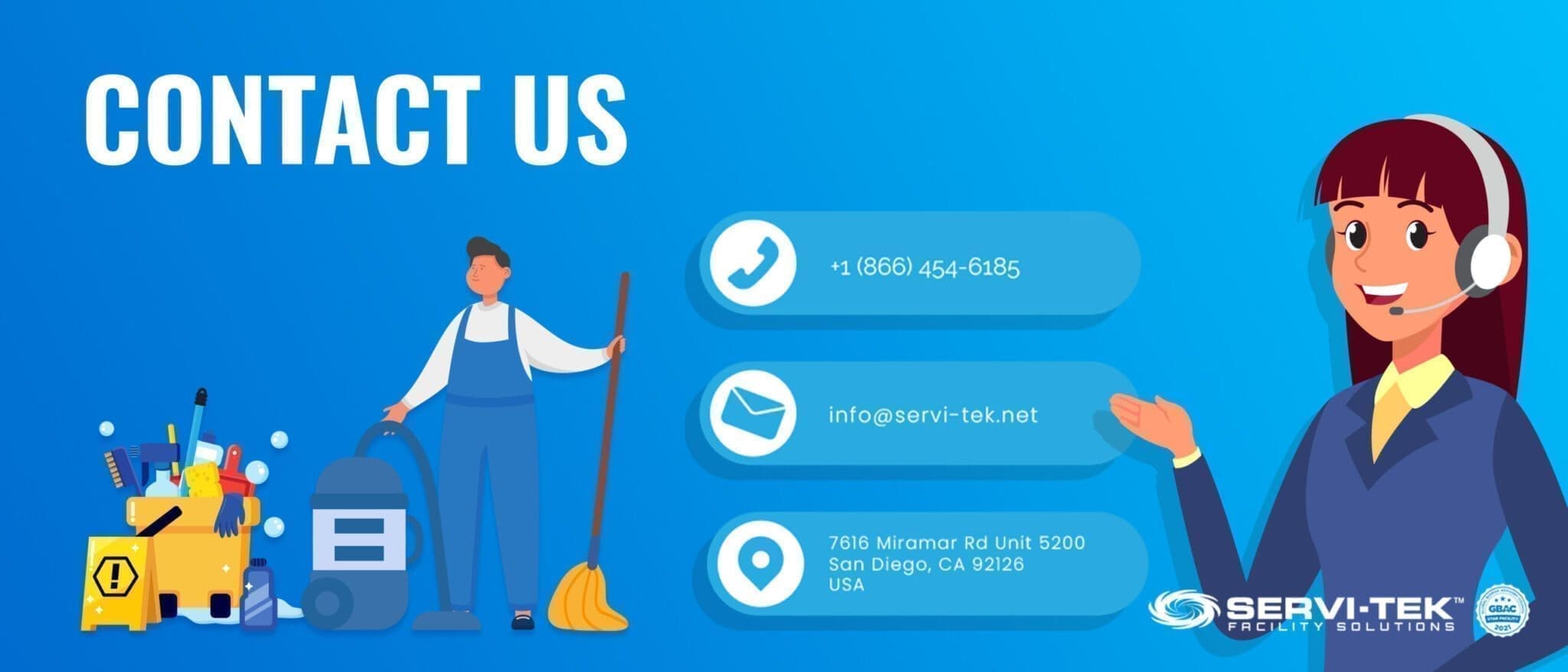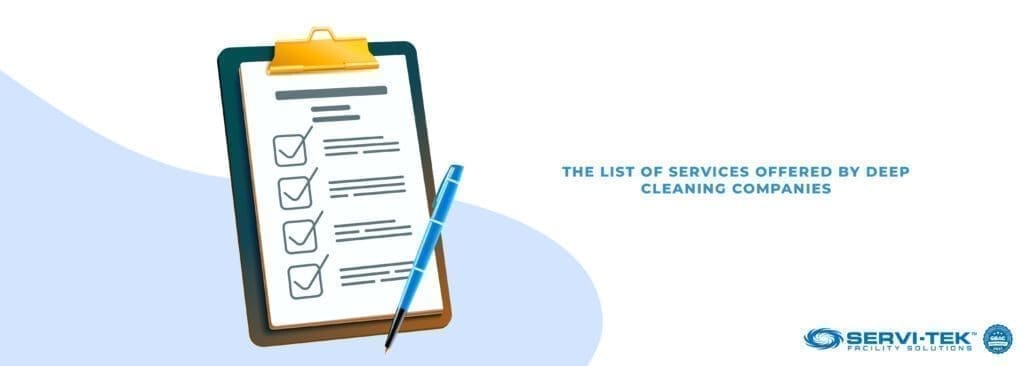
As building owners and facilities management professionals emerge from the COVID-19 pandemic, the time for facility renewal and upkeeping has arrived.
Aside from the regular cleaning services that target dust, dirt, grime, and cobwebs, a higher level of cleanliness is needed. The importance of minimizing germs, viruses, bacteria, and allergens is also critical.
However, many businesses and facility owners ignore the importance of carpet care.
This is a huge error, as carpeting is the first and constant point of contact for anyone entering the facility, and it holds more dirt and health threats than you can imagine.
In this easy-to-read guide, you’ll learn all you must know about carpet care, its importance, and the different types of services you can find out there.
Why Deep Cleaning Is Necessary
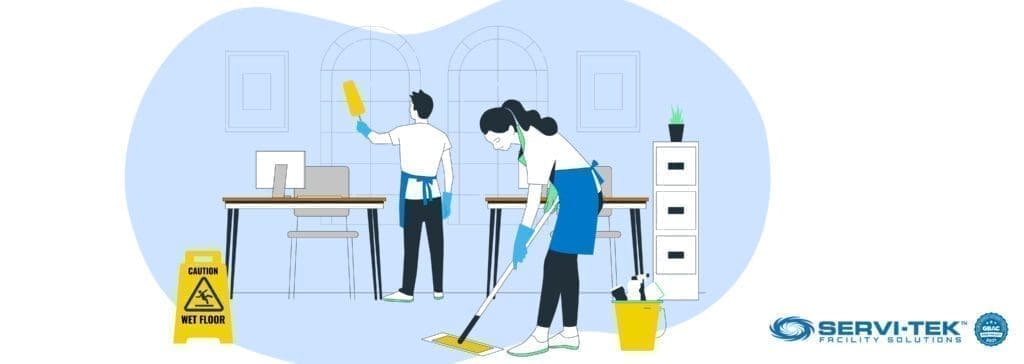
When allocating funds for commercial carpeting, the general understanding is that the product should last from 7 to 15 years. Although the lifespan of carpets is largely related to the amount of foot traffic, proper maintenance plays a key role.
Properly caring for the carpeting in a commercial facility is important for extending its serviceable life.
For example, a facility that purchases 20,000 square feet of average carpeting might spend over $50,000.
Deep cleaning is needed because dirt is not always visible, as debris and bacteria accumulate within the fibers.
Failing to address dirty carpeting may result in higher allergen levels and reduce indoor air quality. These concerns reduce the comfort of the environment and harm the wellness of the building occupants.
Professional carpet care is commonly seen as a process with routine phases.
The typical services are interim maintenance or restorative. The general guidelines from the Carpet and Rug Institute (CRI) suggest that deep cleaning should occur every 12 to 18 months. Very busy workplaces with more people coming and going will need to adopt a more frequent plan.
The CRI’s Seal of Approval (SOA) program outlines four critical steps related to carpet care as follows:
- Regular vacuuming, based on a set schedule, is a critical basic step in this process.
- Spots, spills, trash, or other visible concerns should be quickly addressed.
- Embedded dirt and soil are removed through the process of deep cleaning, which must be ideally performed by a professional cleaning service.
- Take preventative measures such as placing mats near entrances and exits and cleaning and changing air filters to reduce airborne particles.
How Deep Cleaning Works
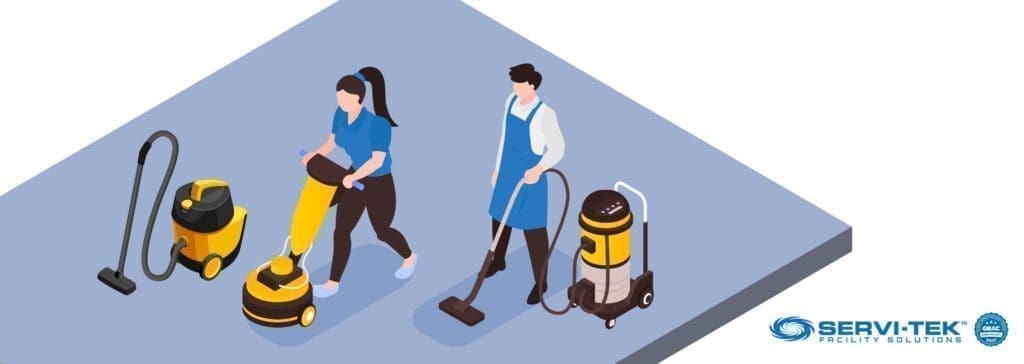
Carpet cleaning professionals first evaluate the characteristics of the specific rug and tailor their process accordingly.
For example, carpeting has many attributes including fiber, colors, and age that respond differently to foot traffic and soil types.
Cleaning processes should be modified accordingly regarding the amount of water to use, the water temperature, and the choice of tools.
Put another way, carpet cleaning and maintenance should be planned, managed, and conducted using the proper chemicals and processes.
Like most types of assets, failing to maintain the materials has consequences that shorten the serviceable life of the material. Also, inconsistently maintaining carpeting might create health concerns, particularly among those with allergies or prone to health issues.
How consistently the soil captured within carpeting is extracted has a large influence on a facility’s overall indoor environmental conditions.
Matting systems are used as a barrier of protection for the surface beneath an entryway and for capturing soils. The process of capturing dust, dirt, and liquid from the footwear of those entering a building should occur upon entry. Durable and easily washable entryway mats absorb the impurities and protect the more costly carpeting from doing so.
As a result, entryway area matting is encouraged and they should be shaken outdoors to remove debris each day. Entryway mats that have a thicker or deeper texture will need more vacuuming compared to thinner or more rubber-based styles.
Getting The Best Results

It is best to follow a deep cleaning checklist and always begins with the removal of loose debris using a high-quality vacuum cleaner. Applying moisture such as soaps and water to carpeting with significant levels of existing debris may encourage material deterioration and be counterproductive.
The vacuum should pass over the carpeting from varying angles to achieve the best results for dislodging the debris.
The next step involves determining if pretreatment is necessary for efficiently removing any stains.
The quality of cleaning agents such as pre-treatment products and detergents tends to vary.
Most experts agree to always start cleaning from the point that is furthest from the exit door. This allows for limiting the likelihood of being forced to walk on areas of wet carpeting. Remember that the best vacuuming head or tool for cleaning might not be the best choice for other applications.
For example, the tool most appropriate for cleaning large carpeted areas may not be recommended for staircases or upholstered furniture. The use of specialized application tools also often applies to the deeply soiled high-traffic entryway areas of the rug.
How do determine the best products and methods for the cleaning process?
The manufacturers of commercial carpeting will provide care and maintenance instructions and recommendations, and these are the safest option. In most cases, the manufacturer has completed lab testing to analyze what works the best.
Some manufacturers may require adherence to a set cleaning schedule to maintain eligibility for property warranty coverage.
Ideally, the carpet chosen for a commercial building is most conducive to the specific operational setting. In new buildings, these decisions could get overlooked and trivialized, which may result in having inappropriate carpeting for the space, which in the long run translates to additional expenses and wasted time.
Carpet Extraction
The term extraction implies an action that removes something by the use of force. In this context, we are referring to the extraction of soils and other unwanted substances from the carpet fibers.
One form of extraction involves using a compound, cloth, or pad to absorb the soil. Active agents are applied and can create a reaction that brings dirt to the surface. These now “suspended” soils are better positioned for removal through vacuuming.
Hot water extraction operates similarly. The process uses water to enhance the removal of all foreign particles.
Deep cleaning requires suspended debris to be completely extracted and the fibers rinsed. The variables that exist in this process include water temperature, pressure (PSI), and the gallons per minute rate of water flow.
The combination of dirt, chemicals, and water is almost entirely extracted and moved through the vacuum hoses for disposal.
Traditional Cleaning is Not Enough
Do you know where all the dust from the carpets, if not properly cleaned, ends up?
It floats in the air and lands on window blinds, window frames, woodwork, light switches, faucets, countertops, ceiling fans, baseboards, and all the appliances in the room.
Then, it reaches the lungs, eyes, skin, and causes allergies and infections.
While more traditional methods remain applicable to certain cleaning tasks, equipment used for commercial carpet cleaning continues to develop, and for good reason.
Certain aspects of floor care can benefit from the deployment of robotics, primarily for enhanced efficiency. One example is using autonomous robotic vacuum cleaners in very large areas such as airports. The majority of these are wireless, which enhances safety and overall practicality.
Along with the enhancements in battery technology, manufacturers have identified ways of creating equipment that is lighter weight.
Assuming the lighter weight equipment still delivers comparable performance, it could help reduce strains, soreness, and injuries among users.
Can Extraction Cleaning Remove Many Stains?
There are many different ways of removing stains from carpeting based on the fiber and nature of the soil. Some deeply entrenched stains will appear to fade away when steam cleaned, but reappear after the fibers dry.
Instead of merely applying steam, extractors use a combination of a powerful liquid and strong suction to dilute and remove stains.
Typically, removing a stain that is composed of oil or grease requires using very hot water. The agitation process may be completed using equipment; however, a stiff brush still works well in limited applications.
Lastly, the cleaning liquid is applied and later extracted, a process that might need repeating for particularly resilient stains.
Carpet Cleaning

As with all commercial cleaning tasks, the carpet cleaning process should be in a documented format. All shampoos, detergents, and chemicals used in the process should also be marked for safety reasons.
Another option to consider is green cleaning products, which are safe for both people and the environment as well.
Carpet cleaning should be completed using the best tools for the job in terms of performance, efficiency, and safety.
For example, a massive carpeted lobby area is probably better suited for a 30-inch vacuum than a 14 inch. One trend in cleaning involves “low moisture” methods that allow for faster dry time, water conservation, and reduced humidity.
The traditional carpet cleaning methods of using shampoo and with a rotary-style machine are less common these days.
One of the methods of cleaning that uses less water involves the application of dry foam. The foam is often composed of 90% air and only 10% liquid. It is applied and allowed to soak in for a short period.
Some carpet fibers today may be cleaned without detergent, by using only water. This process is often referred to as vacuum washing, where water is applied and is immediately extracted. This method is best used for carpeting that contains only small to moderate amounts of dirt and debris.
Carpet Sanitizing

Did you know that commercial carpeting can be sanitized but not disinfected?
Before we begin, familiarize yourself with the following terms:
- Cleaning – can remove viruses but not always destroy them.
- Sanitizing – to make sanitary (as by cleaning or sterilizing); to reduce the occurrence of bacteria, viruses, and fungi.
- Disinfecting – to free from infection especially by destroying harmful microorganisms.
Soft surfaces (including carpet) can be sanitized but not disinfected like many hard surface flooring.
If you look at the directions on disinfectants, you’ll note that it says “for use on hard, non-porous surfaces.”
Pathogens can lurk in the material’s microscopic flaws and crevices. Compare this to a firm, non-porous surface like a stainless-steel tabletop, where germs have nowhere to flee and hide.
Carpet Deodorizing
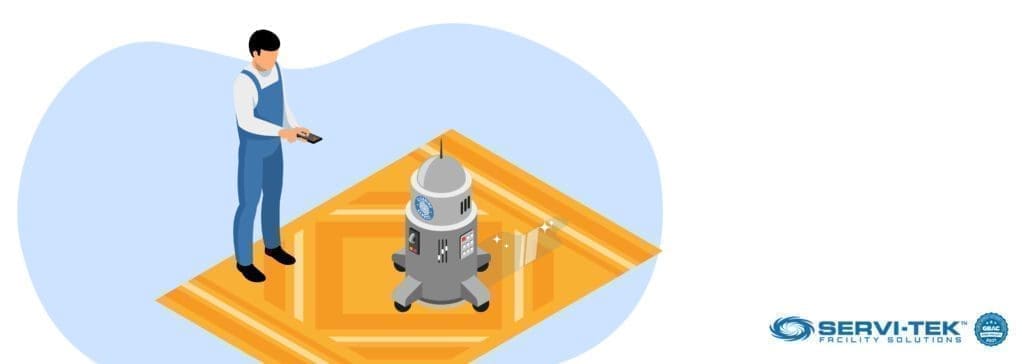
Carpet is an often-overlooked cause for lingering indoor odors.
Foul smells contained within the fibers can create a negative impression on customers, employees, vendors, and other building occupants.
Carpet-based odor is among the leading causes of poor indoor air quality.
What creates odors in commercial carpeting? Anything from food material, soil, or pollen can contribute when they adhere to the fibers or other material. While carpets have a beneficial filtering effect that collects and centralizes dirt and debris, they can be problematic when not maintained.
Moisture is another common odor-causing problem, such as from spills, leaks in roofs or the plumbing system, or other sources. Over the long run, significant accumulations of moisture in carpeting will create mold, that could be odorous and pose respiratory concerns.
One common analogy used when describing the moisture absorption of carpeting is comparing it to a sponge.
Insufficient airflow and poor ventilation are likely to exacerbate carpet-based mold. Moisture and mold might also result from using too much water when cleaning or failing to extract the substances well enough.
Vacuuming
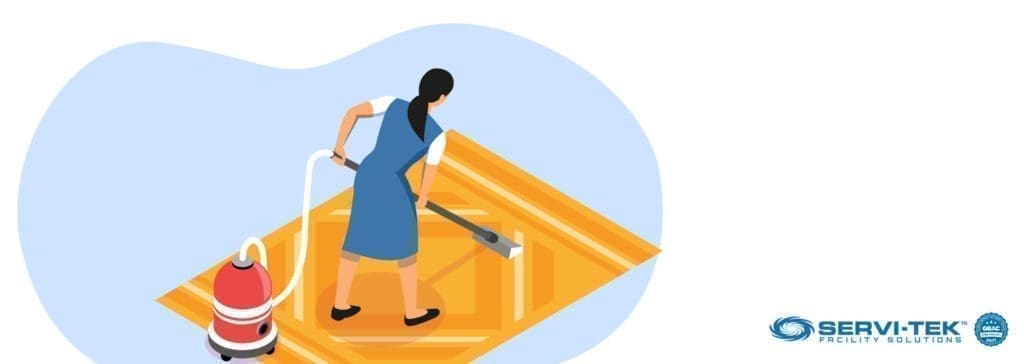
A regular residential vacuum cleaner is insufficient for the constant use required in a large facility.
A commercial-grade or professional duty vacuum cleaner has a backpack, handheld, canister, or upright configuration.
Backpack units usually allow the cleaning professional to operate the machine with one hand. This helps free up the other hand to move other items as they work. Facilities that have multiple floors without an elevator are among those most suitable for backpack units.
Upright models are similar to the traditional residential units based on their outward appearance. The commercial versions of these machines provide better suction, usually have better warranty coverage, and enhance durability.
Vertical or horizontal canister units roll on wheels across the floor and may offer wet and dry vacuuming capability. While being fairly mobile and lightweight, canister models might be less useful in large open carpeted areas.
Handheld models are very mobile. However, they often lack sufficient power and may be more appropriate for stairs and upholstered furniture.
Vacuums rely on creating a strong vortex of suction that routes debris through a hose to a bin. Commercial machines do require regular cleaning of the compartments and hoses to prevent dust accumulations and clogs.
Commercial machines have greater suction power that is typically based on a measurement of cubic feet per minute (CFM). They generally have a greater capacity, meaning less stopping to empty the dust bin.
Fully Licensed and Insured

Experienced facilities professionals recognize the importance of requiring contractors and service providers to be bonded, licensed, and insured.
Commercial cleaning businesses typically have many of the same licensing and insurance requirements; however, state and local laws vary.
Cleaning businesses maintain appropriate coverage as a means of protection from unexpected financial calamities. The first requirement is typically a vendor’s license, which has a basic registration process that might have tax implications. A DBA license might be required when using a trading name and might prevent conflicts with businesses with a similar name.
Most cleaning companies maintain general liability insurance that covers injuries, property damage, or other potential causes of liability.
Worker’s compensation coverage applies to all businesses with employees for covering medical expenses and lost wages after on-the-job injuries. Other common types of coverage include commercial vehicle coverage and business owner policies (BOPS).
Other Services
There are dry chemical compounds are available for cleaning without using liquids. After being applied, the chemicals work to break down the dirt and grime, which is vacuumed up.
Dry cleaning requires no dry time. However, it generally implies more harsh chemicals and doesn’t perform as well as hot water extraction.
Tile Cleaning
Tile is used in many commercial buildings and is easier to maintain than carpeting.
Many tile arrangements have thick grout that will begin to stain and require extra cleaning with a mop. In many cases, grout cleaning is performed with equipment that rotates, scrubs, or otherwise extracts dirt and grime.
Marble Cleaning
Marble is a relatively soft stone that requires using PH-neutral cleaning agents that will not harm the surface.
Surface debris can be quickly and easily swept with a broom or dust mop. Many spots of dirt or stains can be removed using a damp cloth or a mop with warm water.
Leather Cleaning
Leather is a material used on furniture and for wall and floor tiles (to a lesser extent). Leather is durable, but wear tends to be highly visible and certain cleaning products will damage the finishes. There are specific types of soaps used for leather, which contain a moisturizing agent.
Upholstery Cleaning
Objects in commercial environments often have fabric that will become soiled and need cleaning.
Also, upholstery usually accumulates dust, pollutants, and other particles that cause allergies. Cleaning upholstered items pose some potential challenges including the possibility of shrinking, discoloring, or having colors bleed.
Vacuuming is the first step in any upholstery cleaning task. An isolated spot might need treatment.
When in doubt, mild cleaning agents containing distilled water are used or steam heat extraction is used for durable materials.
Rug Cleaning
The transition back to the workplace creates a need for spring cleaning with experts getting back on schedule. In unoccupied buildings, we can expect a large demand for one-time cleanings or deep cleaning services.
However, consistency and partnering with professionals are key elements for future savings and success.
While vacuuming and everyday cleaning eliminate surface filth, only professional cleaners can remove the deep build-up dirt and grime in the fibers.
This will also refresh your surroundings and make the air fresh and the atmosphere welcoming, just as a clean home.
Carpet Steam Cleaning
Pollutants come from a variety of places including:
- Dander from pets, cockroach allergens, and dead bugs.
- Outside foreign particles, tracked in.
- VOCs (volatile organic compounds) from paint, cigarette smoke, and other sources.
Professional carpet steam cleaning will:
Remove Pollutants That Have Been Trapped
- Get Rid of Dust Mite Infestations
- Extend the life of your carpet by preventing mold growth.
- Refresh, renew and restore your facility and impress your clients and staff.
Tools Used in The Cleaning Process
Carpet cleaning professionals know the importance of performing regular preventative maintenance.
The must-have equipment generally includes:
- Vacuum cleaner
- Defoamers
- Air scrubbers
- Crevice tools
- Ventilation assisters
- Carpet cleaning wands
- Protective tools
Equipment that is properly maintained performs better, lasts longer, and reduces the potential for downtime. Following the guidelines of the manufacturer is generally the best option.
After Cleaning
The water and agents used for deep carpeting cleaning should be thoroughly extracted. This allows the fabric to dry and also limits the chances of having a residue that remains in the carpet.
Keep in mind that damp rugs will attract dirt; therefore, using air conditioning or fans might help expedite drying time.
Experts in Deep Carpet Cleaning for Commercial Facilities
At Servi-Tek Facility Solutions, professional deep carpet cleaning is a top option among our comprehensive array of service offerings.
We have spent many years delivering industry-leading results for our clients including building owners and commercial facility managers. Our carpeting cleaning professionals are properly trained and equipped with the latest products and tools needed to be successful.
We have experience providing customized commercial cleaning, janitorial, and facility maintenance solutions for those operating in many business environments.
Some examples include workplaces such as large offices, hospitality, retail, medical facilities, education, and more.
We invite you to contact our local office today for a free estimate!



